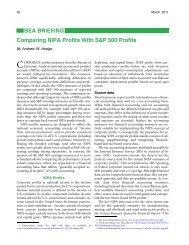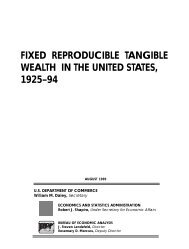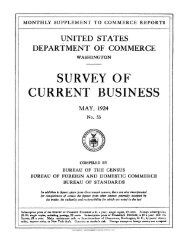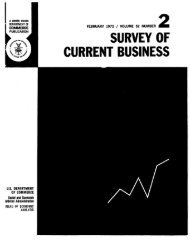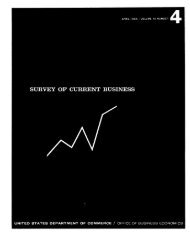the BUSINESS SITUATION - Bureau of Economic Analysis
the BUSINESS SITUATION - Bureau of Economic Analysis
the BUSINESS SITUATION - Bureau of Economic Analysis
Create successful ePaper yourself
Turn your PDF publications into a flip-book with our unique Google optimized e-Paper software.
JL HE investment expansion that<br />
started about 5 years ago has continued<br />
in 1965. By <strong>the</strong> third quarter,<br />
gross private domestic investment was<br />
$9 billion above <strong>the</strong> 1964 rate. Most<br />
<strong>of</strong> this advance was in nonresidential<br />
fixed investment, which increased<br />
through <strong>the</strong> first three quarters, continuing<br />
<strong>the</strong> steep rise that has been<br />
underway for a few years. Third<br />
quarter inventory accumulation, though<br />
down from <strong>the</strong> peak <strong>of</strong> <strong>the</strong> first quarter<br />
<strong>of</strong> 1965, was also above last year's pace.<br />
In contrast, outlays on residential<br />
structures were at about <strong>the</strong> same rate<br />
as <strong>the</strong>y were in <strong>the</strong> middle <strong>of</strong> 1964,<br />
having fluctuated without any apparent<br />
trend since <strong>the</strong>n. They are still<br />
,a little below <strong>the</strong> peaks reached early<br />
last year. Net foreign investment was<br />
somewhat lower this year than last.<br />
The rise in private investment was<br />
matched by a rise in private saving from<br />
1964 to <strong>the</strong> third quarter <strong>of</strong> this year.<br />
Undistributed corporate pr<strong>of</strong>its rose<br />
$6 billion—mostly during <strong>the</strong> first<br />
half—and accounted for two-thirds <strong>of</strong><br />
<strong>the</strong> advance. The corporate cash flow<br />
was augmented by a $2% billion advance<br />
in capital consumption allowances.<br />
Personal saving, which had been low<br />
during <strong>the</strong> first half, moved up sharply<br />
in <strong>the</strong> third quarter, to a volume about<br />
$1 billion above <strong>the</strong> 1964 rate.<br />
The difference between Federal receipts<br />
and expenditures on income and<br />
product account displayed a pattern<br />
just <strong>the</strong> opposite <strong>of</strong> that shown by<br />
personal saving. During <strong>the</strong> first half<br />
<strong>of</strong> 1965, <strong>the</strong> Federal Government<br />
showed a surplus averaging $2}£ billion<br />
(annual rate); during <strong>the</strong> third quarter,<br />
it ran a deficit <strong>of</strong> $4 billion. To a<br />
large extent, <strong>the</strong>se swings in personal<br />
saving and <strong>the</strong> budget position were<br />
closely related. Early in <strong>the</strong> year,<br />
791-025 O - 65 - 2<br />
higher personal tax settlements on 1964<br />
incomes boosted <strong>the</strong> Government surplus<br />
and held down <strong>the</strong> rise in disposable<br />
income and savings; in <strong>the</strong> third<br />
quarter, <strong>the</strong> cessation <strong>of</strong> <strong>the</strong>se settlements<br />
and <strong>the</strong> retroactive Social Security<br />
payment tended to raise personal<br />
saving while increasing <strong>the</strong> Government<br />
deficit.<br />
Percent<br />
5.00<br />
4.75<br />
4.50<br />
4.25<br />
Interest Rates<br />
by JOHN A. GORMAN and PAUL E. SHEA<br />
Recent Financial Developments<br />
CHART 7<br />
Long-term rates have moved up this year<br />
Newly Issued Corporate Aa Bonds<br />
(Seasonally Adjusted)<br />
4.00 I I I I I I I I I I I I I I I I 1 I ! I I I<br />
4.75<br />
4.50<br />
4.25<br />
4.00<br />
3.75<br />
3.50<br />
U.S. Treasury Taxable Bonds<br />
short-term rates peaked early in <strong>the</strong> year<br />
Prime Commercial Paper<br />
(4-6 months)<br />
U.S. Treasury Bills<br />
(New Issues)<br />
3.25 I I I I I I I I I 1 I I I I I I ! I I I I I I<br />
1964 1965<br />
Data: Treas., FHA, Moody's & FRB<br />
U.S. Department <strong>of</strong> Commerce, Office <strong>of</strong> Business <strong>Economic</strong>s 65-11-7<br />
Contrast with earlier expansions<br />
The investment expansion, toge<strong>the</strong>r<br />
with increases in consumer purchases<br />
<strong>of</strong> autos and o<strong>the</strong>r durable goods, led<br />
to a marked rise in <strong>the</strong> demand for<br />
credit, which was largely accommodated<br />
at stable or slightly rising interest rates.<br />
This is in marked contrast to developments<br />
during previous periods <strong>of</strong> investment<br />
growth, for example, those <strong>of</strong><br />
1955-57 and 1959-60, when increased<br />
credit demands were accompanied by<br />
sharp increases in interest rates.<br />
The comparative stability <strong>of</strong> interest<br />
rates during <strong>the</strong> economic advance<br />
that started in 1961 has reflected two<br />
major developments that differ from<br />
earlier experience: Corporate internal<br />
funds have advanced almost without<br />
interruption, and monetary policy has<br />
been more oriented toward keeping<br />
interest rates stable.<br />
Corporate pr<strong>of</strong>its before taxes have<br />
risen almost every quarter during <strong>the</strong><br />
past 5 years, whereas pr<strong>of</strong>its peaked<br />
ra<strong>the</strong>r early in previous expansions.<br />
The beneficial effects <strong>of</strong> this pr<strong>of</strong>it<br />
performance on internal funds were<br />
enhanced by <strong>the</strong> liberalization <strong>of</strong> tax<br />
depreciation regulations, by <strong>the</strong> tax<br />
credit on new investment, and by reductions<br />
in corporate tax rates. Although<br />
dividends were increased substantially<br />
over this period, internal funds rose<br />
$24 billion from early 1961 through <strong>the</strong><br />
summer <strong>of</strong> this year.<br />
Over most <strong>of</strong> <strong>the</strong> current economic expansion,<br />
<strong>the</strong> rapid growth in corporate<br />
investment has lagged behind <strong>the</strong> rise<br />
in internal funds, corporation borrowing<br />
has been limited, and liquid assets<br />
have been well maintained. In contrast,<br />
earlier economic expansions were<br />
characterized by a rise in investment<br />
9



